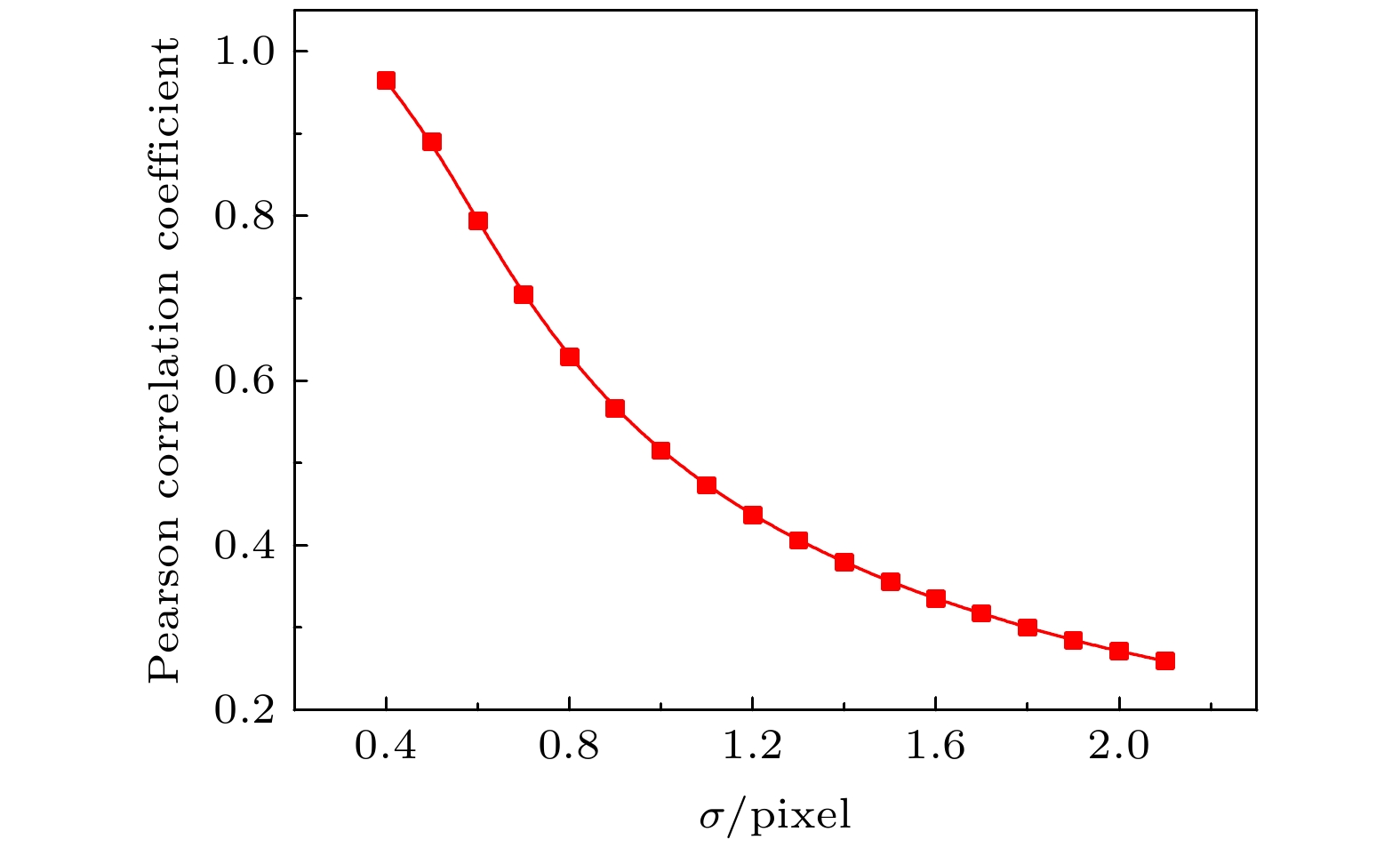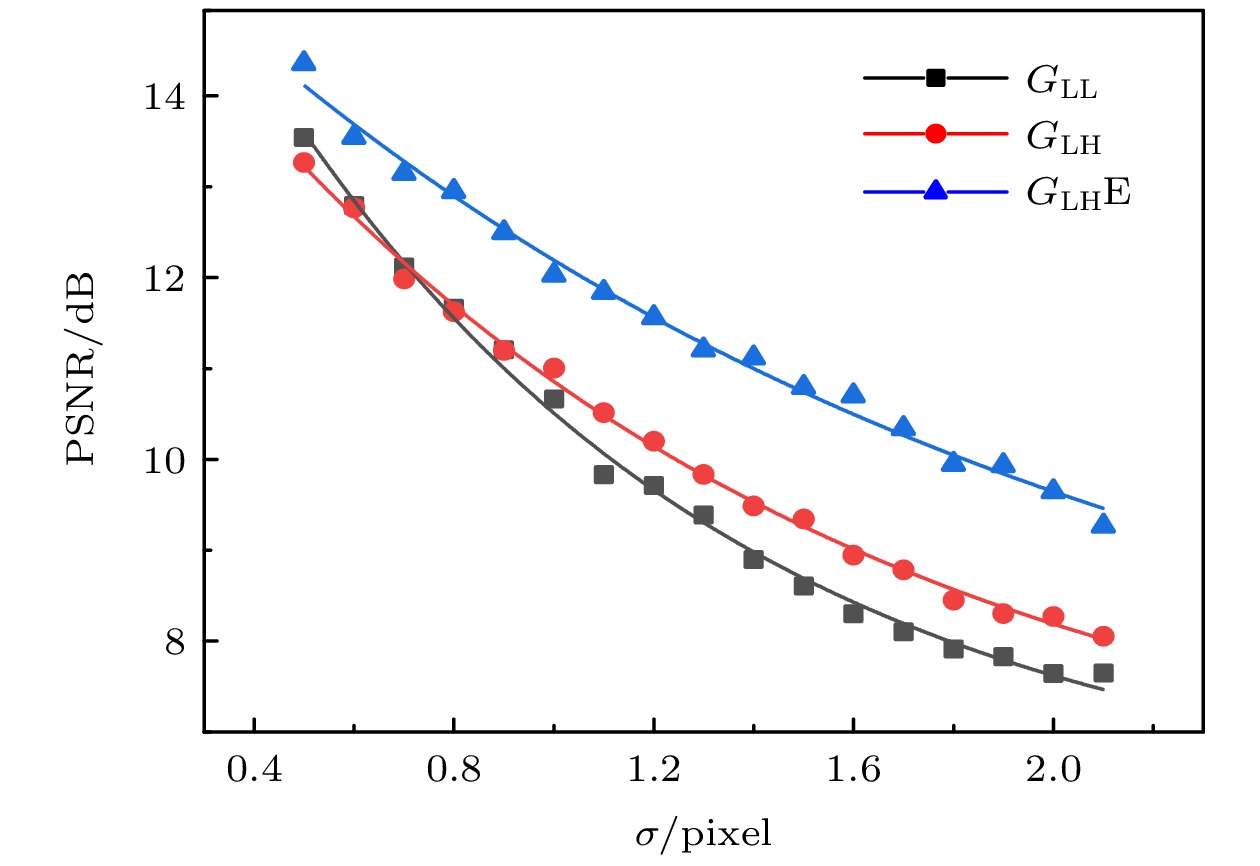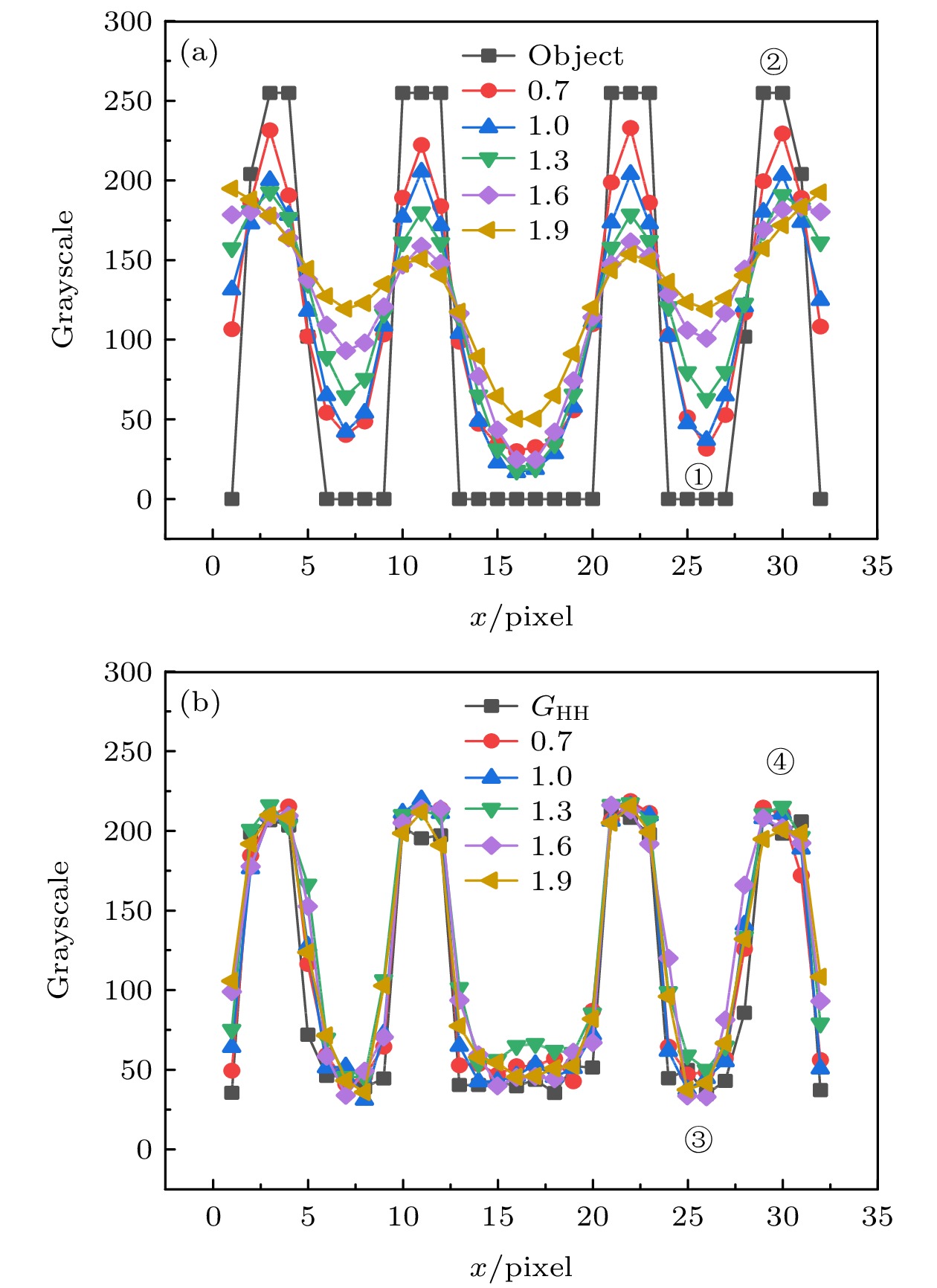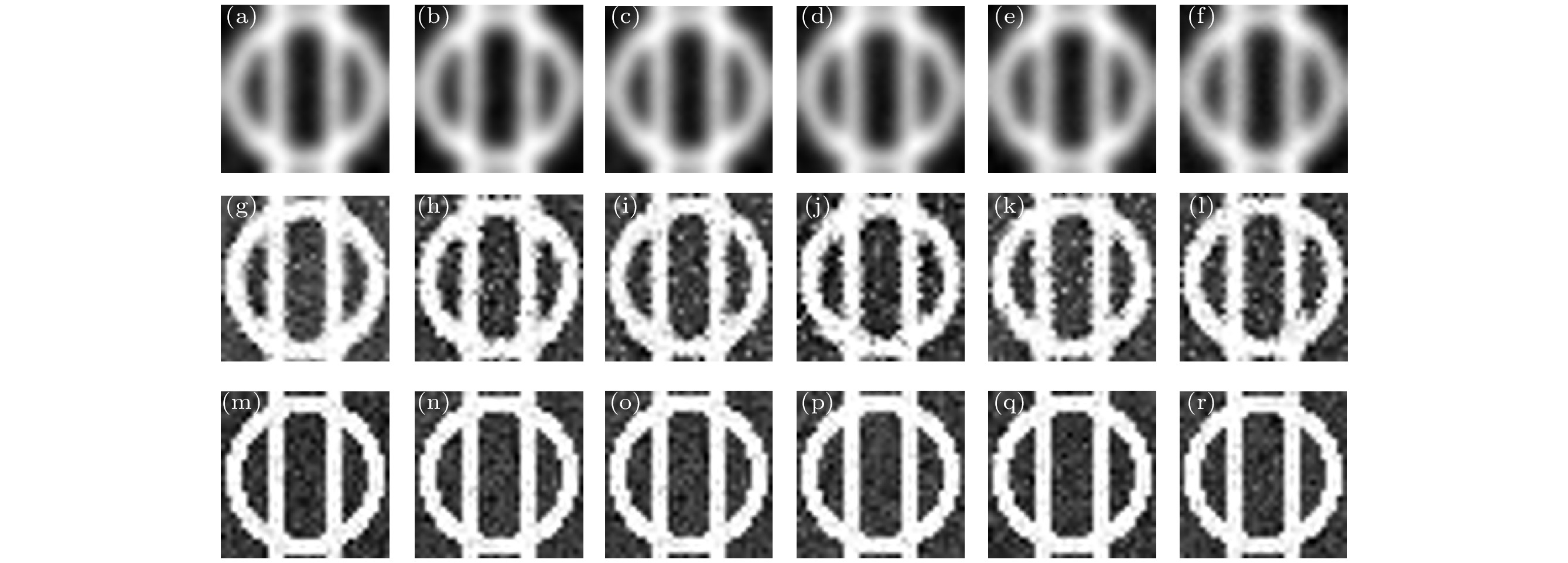-
X射线鬼成像是一种低剂量、非定域成像方法, 对医疗诊断和生物成像具有重要意义. 在基于晶体劳厄衍射分光的X射线鬼成像中, 晶体振动会造成衍射光路上散斑的模糊, 进而导致利用关联方法重构图像衬度和空间分辨的降低. 本文系统分析了衍射光路上散斑图像的模糊程度对归一化二阶关联函数
$ {g}^{\left(2\right)} $ 的最大值和半高全宽的影响. 模糊程度的增强会导致$ {g}^{\left(2\right)} $ 最大值的减小和半高全宽的展宽, 在理论上证明了模糊程度会引起重构图像的衬度和分辨能力的降低. 为解决上述问题, 本文在衍射光路和直通光路的直接关联方法($ {G}_{\mathrm{L}\mathrm{H}} $ )的基础上提出$ {G}_{\mathrm{L}\mathrm{H}}E $ 方法($ {G}_{\mathrm{L}\mathrm{H}} $ enhanced method). 模拟实验表明$ {G}_{\mathrm{L}\mathrm{H}}E $ 算法能同时改善图像衬度和提高重构分辨率, 并且模糊程度增强时,$ {G}_{\mathrm{L}\mathrm{H}}E $ 算法重构图像的峰值信噪比与先对直通光路的散斑图像进行高斯滤波处理再进行双光路关联计算方法($ {G}_{\mathrm{L}\mathrm{L}} $ )的差距扩大, 同时保证其对噪声的鲁棒性. 本文为晶体衍射分光的X射线鬼成像的实际应用提供可行的思路.X-ray ghost imaging is a low-dose, non-localized imaging method, which is of great significance in medical diagnosis and biological imaging. In crystal diffraction based X-ray ghost imaging, the blurring patterns in the diffracted beam, caused by the crystal vibration, can result in a reduction in the contrast and spatial resolution of the reconstructed imaged by ensemble average. In the paper, we systematically analyze the influence of the blurring degree of the speckle patterns from the diffracted beam on the normalized second-order intensity correlation function$ {g}^{\left(2\right)} $ numerically and theoretically. Both demonstrates that as the blurring degree increases, the maximum value of$ {g}^{\left(2\right)} $ decreases and the full width at half maximum broadens, which theoretically proves the blurring degree relating to image quality. In order to solve the above problem, in the paper we propose a$ {G}_{\mathrm{L}\mathrm{H}} $ enhanced ($ {G}_{\mathrm{L}\mathrm{H}}\mathrm{E} $ ) method to optimize the image quality based on the scheme ($ {G}_{\mathrm{L}\mathrm{H}} $ ) which directly correlates the bucket signals in diffracted beam with the high-definition patterns in transmitted beam. The simulation experiments exhibit that the$ {G}_{\mathrm{L}\mathrm{H}}\mathrm{E} $ method can improve both the image contrast and the spatial resolution simultaneously. As the blurring degree increases, the difference between the peak signal-to noise ratio of the reconstructed image by the iterative method and that by the scheme$ {(G}_{\mathrm{L}\mathrm{L}}) $ which preprocess the speckle patterns in the transmitted beam through Gaussian filtering, becomes greater. Furthermore, the${G}_{\mathrm{L}\mathrm{H}}\mathrm{E} $ is almost immune to the additive noise. In summary, the present study provides a feasible idea for the practical application of X-ray ghost imaging based on crystal diffraction.-
Keywords:
- X-ray ghost imaging /
- crystal diffraction /
- imaging quality /
- normalized second-order intensity correlation
[1] Bennink R S, Bentley S J, Boyd R W, Howell J C 2004 Phys. Rev. Lett. 92 033601
 Google Scholar
Google Scholar
[2] Ferri F, Magatti D, Gatti A, Bache M, Brambilla E, Lugiato L A 2005 Phys. Rev. Lett. 94 183602
 Google Scholar
Google Scholar
[3] Valencia A, Scarcelli G, D’Angelo M, Shih Y 2005 Phys. Rev. Lett. 94 063601
 Google Scholar
Google Scholar
[4] Pittman T, Shih Y, Strekalov D, Sergienko A 1995 Phys. Rev. A 52 R3429
 Google Scholar
Google Scholar
[5] Zhang D, Zhai Y H, Wu L A, Chen X H 2005 Opt. Lett. 30 2354
 Google Scholar
Google Scholar
[6] Chan K W C, O'Sullivan M N, Boyd R W 2009 Opt. Lett. 34 3343
 Google Scholar
Google Scholar
[7] Cao D Z, Xiong J, Wang K 2005 Phys. Rev. A 71 013801
 Google Scholar
Google Scholar
[8] Strekalov D V, Sergienko A V, Klyshko D N, Shih Y H 1995 Phys. Rev. Lett. 74 3600
 Google Scholar
Google Scholar
[9] Bennink R S, Bentley S J, Boyd R W 2002 Phys. Rev. Lett. 89 113601
 Google Scholar
Google Scholar
[10] Yu W K, Liu X F, Yao X R, Wang C, Zhai G J, Zhao Q 2014 Phys. Rev. A 378 3406
[11] Cheng J 2009 Opt. Express 17 7916
 Google Scholar
Google Scholar
[12] Shi D, Fan C, Zhang P, Zhang J, Shen H, Qiao C, Wang Y 2012 Opt. Express 20 27992
 Google Scholar
Google Scholar
[13] 李明飞, 阎璐, 杨然, 寇军, 刘院省 2019 68 094204
 Google Scholar
Google Scholar
Li M F, Yan L, Yang R, Kou J, Liu Y X 2019 Acta Phys. Sin. 68 094204
 Google Scholar
Google Scholar
[14] Oh J E, Cho Y W, Scarcelli G, Kim Y H 2013 Opt. Lett. 38 682
 Google Scholar
Google Scholar
[15] Zhao C, Gong W, Chen M, Li E, Wang H, Wendong X, Han A 2012 Appl. Phys. Lett. 101 141123
 Google Scholar
Google Scholar
[16] Ma S, Liu Z, Wang C, Hu C, Li E, Gong W, Tong Z, Wu J, Shen X, Han S 2019 Opt. Express 27 13219
 Google Scholar
Google Scholar
[17] Boto A N, Kok P, Abrams D S, Braunstein S L, Williams C P, Dowling J P 2000 Phys. Rev. Lett. 85 2733
 Google Scholar
Google Scholar
[18] D'Angelo M, Chekhova M V, Shih Y 2001 Phys. Rev. Lett. 87 013602
 Google Scholar
Google Scholar
[19] Li S, Yao X R, Yu W K, Wu L A, Zhai G J 2013 Opt. Lett. 38 2144
 Google Scholar
Google Scholar
[20] Cheng J, Han S 2004 Phys. Rev. Lett. 92 093903
 Google Scholar
Google Scholar
[21] Chen X H, Agafonov I N, Luo K H, Liu Q, Xian R, Chekhova M V, Wu L A 2010 Opt. Lett. 35 1166
 Google Scholar
Google Scholar
[22] Chen X H, Liu Q, Luo K H, Wu L A 2009 Opt. Lett. 34 695
 Google Scholar
Google Scholar
[23] Li S, Cropp F, Kabra K, Lane T J, Wetzstein G, Musumeci P, Ratner D 2018 Phys. Rev. Lett. 121 114801
 Google Scholar
Google Scholar
[24] Kingston A M, Myers G R, Pelliccia D, Salvemini F, Bevitt J J, Garbe U, Paganin D M 2020 Phys. Rev. A 101 053844
 Google Scholar
Google Scholar
[25] Pelliccia D, Olbinado M, Rack A, Kingston A, Myers G, Paganin D 2018 IUCrJ 5 428
 Google Scholar
Google Scholar
[26] Kingston A M, Pelliccia D, Rack A, Olbinado M P, Cheng Y, Myers G R, Paganin D M 2018 Optica 5 1516
 Google Scholar
Google Scholar
[27] Zhang A X, He Y H, Wu L A, Chen L M, Wang B B 2018 Optica 5 374
 Google Scholar
Google Scholar
[28] Klein Y, Schori A, Dolbnya I P, Sawhney K, Shwartz S 2019 Opt. Express 27 3284
 Google Scholar
Google Scholar
[29] Schori A, Shwartz S 2017 Opt. Express 25 14822
 Google Scholar
Google Scholar
[30] Schori A, Borodin D, Tamasaku K, Shwartz S 2018 Phys. Rev. A 97 063804
 Google Scholar
Google Scholar
[31] Pelliccia D, Rack A, Scheel M, Cantelli V, Paganin D M 2016 Phys. Rev. Lett. 117 113902
 Google Scholar
Google Scholar
[32] Yu H, Lu R, Han S, Xie H, Du G, Xiao T, Zhu D 2016 Phys. Rev. Lett. 117 113901
 Google Scholar
Google Scholar
[33] He Y H, Zhang A X, Li M F, Huang Y Y, Quan B G, Li D Z, Wu L A, Chen L M 2020 APL Photonics 5 056102
 Google Scholar
Google Scholar
[34] 孙海峰, 包为民, 方海燕, 李小平 2014 63 069701
 Google Scholar
Google Scholar
Sun H F, Bao F W, Fang H Y, Li X P 2014 Acta Phys. Sin. 63 069701
 Google Scholar
Google Scholar
[35] 刘雪峰, 姚旭日, 李明飞, 俞文凯, 陈希浩, 孙志斌, 吴 令安, 翟光杰 2013 62 184205
 Google Scholar
Google Scholar
Liu X F, Yao X R, Li M F, Yu W K, Chen X H, Sun Z B, Wu L A, Zhai G J 2013 Acta Phys. Sin. 62 184205
 Google Scholar
Google Scholar
[36] Zhao C Z, Si S Y, Zhang H P, Xue L , Li Z L, Xiao T Q 2021 Acta Phys. Sin. 70
 Google Scholar
Google Scholar
-
图 3 当
$ \sigma =1.3 $ 时光强归一化二阶关联的理论和模拟在x方向上的曲线图 (a)$ {g}_{\mathrm{L}\mathrm{L}}^{\left(2\right)}\mathrm{和}{g}_{\mathrm{L}\mathrm{H}}^{\left(2\right)} $ 的模拟在x方向上的曲线图; (b)${g}_{\mathrm{L}\mathrm{L}}^{\left(2\right)} $ $ \mathrm{和}{g}_{\mathrm{L}\mathrm{H}}^{\left(2\right)}$ 的理论在x方向上的曲线图Fig. 3. The theoretical and simulated curves of the normalized second-order correlation of light intensity in x direction when
$ \sigma =1.3: $ (a) The simulated curves of$ {g}_{\mathrm{L}\mathrm{L}}^{\left(2\right)} $ and$ {g}_{\mathrm{L}\mathrm{H}}^{\left(2\right)} $ in x direction; (b) the theoretical curves of$ {g}_{\mathrm{L}\mathrm{L}}^{\left(2\right)} $ and$ {g}_{\mathrm{L}\mathrm{H}}^{\left(2\right)} $ in x direction.图 4
$ {g}_{\mathrm{L}\mathrm{L}}^{\left(2\right)} $ 和$ {g}_{\mathrm{L}\mathrm{H}}^{\left(2\right)} $ 在理论和模拟上随模糊程度$ \sigma $ 的变化曲线图 (a)$ {\mathrm{g}}_{\mathrm{L}\mathrm{L}}^{\left(2\right)} $ 和${g}_{\mathrm{L}\mathrm{H}}^{\left(2\right)}$ 在理论和模拟的最大值随$ \sigma $ 的变化; (b)$ {g}_{\mathrm{L}\mathrm{L}}^{\left(2\right)} $ 和${g}_{\mathrm{L}\mathrm{H}}^{\left(2\right)}$ 在理论和模拟的半高全宽随$ \sigma $ 的变化Fig. 4.
${g}_{\mathrm{L}\mathrm{L}}^{\left(2\right)}~\mathrm{and}~{g}_{\mathrm{L}\mathrm{H}}^{\left(2\right)}$ vary with the blur degree$ \sigma $ in theory and simulation: (a) The theoretical and simulated maximum of${g}_{\mathrm{L}\mathrm{L}}^{\left(2\right)}\mathrm{~and~}{g}_{\mathrm{L}\mathrm{H}}^{\left(2\right)}$ vary with$ \sigma $ ; (b) the FWHM of${g}_{\mathrm{L}\mathrm{L}}^{\left(2\right)}~\mathrm{and}~{g}_{\mathrm{L}\mathrm{H}}^{\left(2\right)}$ vary with$ \sigma $ in theory and simulation.图 5
${G}_{\mathrm{L}\mathrm{L}} $ 和$ {G}_{\mathrm{L}\mathrm{H}}\mathrm{E} $ 方法重构图像 (a) 物体图像; (b)—(f) 不同标准差($ \sigma $ = 0.7, 1.0, 1.3, 1.6, 1.9)时$ {G}_{\mathrm{L}\mathrm{L}} $ 恢复的图像; (g)$ {G}_{\mathrm{H}\mathrm{H}} $ 重构的图像; (h)—(l) 不同标准差($ \sigma $ = 0.7, 1.0, 1.3, 1.6, 1.9)时$ {G}_{\mathrm{L}\mathrm{H}}\mathrm{E} $ 方法恢复的图像.Fig. 5. Images reconstructed by
$ {G}_{\mathrm{L}\mathrm{L}} $ and iterative method: (a) The object image; (b)-(f) the images are retrieved by$ {G}_{\mathrm{L}\mathrm{L}} $ with$ \sigma $ set as 0.7, 1.0, 1.3, 1.6, 1.9; (g) the image restored by$ {G}_{\mathrm{H}\mathrm{H}} $ ; (h)-(l) the images are reconstructed by iterative method when$ \sigma $ is 0.7, 1.0, 1.3, 1.6, 1.9.图 7
$ {G}_{\mathrm{L}\mathrm{L}} $ 和$ {G}_{\mathrm{L}\mathrm{H}}\mathrm{E} $ 方法重构图像中间部位的截面轮廓线:(a) 黑线是物体的截面轮廓线, 即图5(a)中间区域的平均灰度变化, 其余分别是$ {G}_{\mathrm{L}\mathrm{L}} $ 方法在$ \sigma $ 为0.7, 1.0, 1.3, 1.6, 1.9时重构图像的截面轮廓线, 即图5(b)到图5(f)的中间区域的平均灰度变化; (b) 黑线是GHH重构图像的截面轮廓线, 即图5(g)中间区域的平均灰度变化, 其余是$ {G}_{\mathrm{L}\mathrm{H}}\mathrm{E} $ 方法在$ \sigma $ 为0.7, 1.0, 1.3, 1.6, 1.9时重构图像的截面轮廓线,即图5(h)到图5(l)的中间区域的平均灰度变化.Fig. 7. Line profiles of the middle parts in the reconstructed images by
$ {G}_{\mathrm{L}\mathrm{L}} $ and$ {G}_{\mathrm{L}\mathrm{H}}\mathrm{E} $ : (a) The black curve is the line profile of the object, that is the mean grayscale change of the middle part in Fig. 5(a), and the rest is the line profiles of the images retrieved by$ {G}_{\mathrm{L}\mathrm{L}} $ with$ \sigma $ set as 0.7, 1.0, 1.3, 1.6, 1.9, that is, the mean grayscale change of the middle part in Fig. 5(b) to Fig. 5(f); (b) the black curve is the line profile of the image retrieved by$ {G}_{\mathrm{H}\mathrm{H}} $ , that is the mean grayscale change of the middle part in Fig. 5(g), and the rest is the line profiles of the images restored by$ {G}_{\mathrm{L}\mathrm{H}}\mathrm{E} $ when$ \sigma $ is 0.7, 1.0, 1.3, 1.6, 1.9, that is, the mean grayscale change of the middle part in Fig. 5(h) to Fig. 5(l).图 8
$ {G}_{\mathrm{L}\mathrm{L}} $ ,$ {G}_{\mathrm{L}\mathrm{H}}\mathrm{E} $ ,$ {G}_{\mathrm{H}\mathrm{H}} $ 在不同噪声下重构图像: (a), (g), (m) 无噪声时$ {G}_{\mathrm{L}\mathrm{L}} $ ,$ {G}_{\mathrm{L}\mathrm{H}}\mathrm{E} $ ,$ {G}_{\mathrm{H}\mathrm{H}} $ 重构的图像; (b)—(f)$ {\mathrm{G}}_{\mathrm{L}\mathrm{L}} $ 在均值为0.1, 标准差为0.05, 0.1, 0.15, 0.2, 0.25时重构的图像; (i)—(l)$ {G}_{\mathrm{L}\mathrm{H}}\mathrm{E} $ 在均值为0.1, 标准差为0.05, 0.1, 0.15, 0.2, 0.25时重构的图像; (n)—(r)$ {G}_{\mathrm{H}\mathrm{H}} $ 在均值为0.1, 标准差为0.05, 0.1, 0.15, 0.2, 0.25时重构的图像Fig. 8. Images reconstructed by
$ {G}_{\mathrm{L}\mathrm{L}} $ ,$ {G}_{\mathrm{L}\mathrm{H}}\mathrm{E} $ ,$ {G}_{\mathrm{H}\mathrm{H}} $ under different noise: (a), (g), (m) the images reconstructed by$ {G}_{\mathrm{L}\mathrm{L}} $ ,$ {G}_{\mathrm{L}\mathrm{H}}\mathrm{E} $ ,$ {G}_{\mathrm{H}\mathrm{H}} $ without noise; (b)–(f) the images reconstructed by$ {G}_{\mathrm{L}\mathrm{L}} $ under the noise with the mean of 0.1 and the standard deviation of 0.05, 0.1, 0.15, 0.2, 0.25 respectively; (i)–(l) the images reconstructed by$ {G}_{\mathrm{L}\mathrm{H}}\mathrm{E} $ under the noise with the mean of 0.1 and the standard deviation of 0.05, 0.1, 0.15, 0.2, 0.25 respectively; (n)–(r) the images reconstructed by$ {G}_{\mathrm{H}\mathrm{H}} $ under the noise with the mean of 0.1 and the standard deviation of 0.05, 0.1, 0.15, 0.2, 0.25 respectively.图 9
$ {G}_{\mathrm{L}\mathrm{L}} $ ,$ {G}_{\mathrm{L}\mathrm{H}}\mathrm{E} $ ,$ {G}_{\mathrm{H}\mathrm{H}} $ 在不同噪声下重构图像的PSNR, 其中标准差$ {\sigma }_{\mathrm{N}} $ 为0表示没有噪声(此时噪声均值$ {\mu }_{\mathrm{N}} $ 也为0)Fig. 9. PSNRs of images reconstructed by
$ {G}_{\mathrm{L}\mathrm{L}} $ ,$ {G}_{\mathrm{L}\mathrm{H}}\mathrm{E} $ ,$ {G}_{\mathrm{H}\mathrm{H}} $ under different noise, where the standard deviation$ {\sigma }_{\mathrm{N}} $ of 0 indicates there is no noise (at this time the mean$ {\mu }_{\mathrm{N}} $ of noise is also 0). -
[1] Bennink R S, Bentley S J, Boyd R W, Howell J C 2004 Phys. Rev. Lett. 92 033601
 Google Scholar
Google Scholar
[2] Ferri F, Magatti D, Gatti A, Bache M, Brambilla E, Lugiato L A 2005 Phys. Rev. Lett. 94 183602
 Google Scholar
Google Scholar
[3] Valencia A, Scarcelli G, D’Angelo M, Shih Y 2005 Phys. Rev. Lett. 94 063601
 Google Scholar
Google Scholar
[4] Pittman T, Shih Y, Strekalov D, Sergienko A 1995 Phys. Rev. A 52 R3429
 Google Scholar
Google Scholar
[5] Zhang D, Zhai Y H, Wu L A, Chen X H 2005 Opt. Lett. 30 2354
 Google Scholar
Google Scholar
[6] Chan K W C, O'Sullivan M N, Boyd R W 2009 Opt. Lett. 34 3343
 Google Scholar
Google Scholar
[7] Cao D Z, Xiong J, Wang K 2005 Phys. Rev. A 71 013801
 Google Scholar
Google Scholar
[8] Strekalov D V, Sergienko A V, Klyshko D N, Shih Y H 1995 Phys. Rev. Lett. 74 3600
 Google Scholar
Google Scholar
[9] Bennink R S, Bentley S J, Boyd R W 2002 Phys. Rev. Lett. 89 113601
 Google Scholar
Google Scholar
[10] Yu W K, Liu X F, Yao X R, Wang C, Zhai G J, Zhao Q 2014 Phys. Rev. A 378 3406
[11] Cheng J 2009 Opt. Express 17 7916
 Google Scholar
Google Scholar
[12] Shi D, Fan C, Zhang P, Zhang J, Shen H, Qiao C, Wang Y 2012 Opt. Express 20 27992
 Google Scholar
Google Scholar
[13] 李明飞, 阎璐, 杨然, 寇军, 刘院省 2019 68 094204
 Google Scholar
Google Scholar
Li M F, Yan L, Yang R, Kou J, Liu Y X 2019 Acta Phys. Sin. 68 094204
 Google Scholar
Google Scholar
[14] Oh J E, Cho Y W, Scarcelli G, Kim Y H 2013 Opt. Lett. 38 682
 Google Scholar
Google Scholar
[15] Zhao C, Gong W, Chen M, Li E, Wang H, Wendong X, Han A 2012 Appl. Phys. Lett. 101 141123
 Google Scholar
Google Scholar
[16] Ma S, Liu Z, Wang C, Hu C, Li E, Gong W, Tong Z, Wu J, Shen X, Han S 2019 Opt. Express 27 13219
 Google Scholar
Google Scholar
[17] Boto A N, Kok P, Abrams D S, Braunstein S L, Williams C P, Dowling J P 2000 Phys. Rev. Lett. 85 2733
 Google Scholar
Google Scholar
[18] D'Angelo M, Chekhova M V, Shih Y 2001 Phys. Rev. Lett. 87 013602
 Google Scholar
Google Scholar
[19] Li S, Yao X R, Yu W K, Wu L A, Zhai G J 2013 Opt. Lett. 38 2144
 Google Scholar
Google Scholar
[20] Cheng J, Han S 2004 Phys. Rev. Lett. 92 093903
 Google Scholar
Google Scholar
[21] Chen X H, Agafonov I N, Luo K H, Liu Q, Xian R, Chekhova M V, Wu L A 2010 Opt. Lett. 35 1166
 Google Scholar
Google Scholar
[22] Chen X H, Liu Q, Luo K H, Wu L A 2009 Opt. Lett. 34 695
 Google Scholar
Google Scholar
[23] Li S, Cropp F, Kabra K, Lane T J, Wetzstein G, Musumeci P, Ratner D 2018 Phys. Rev. Lett. 121 114801
 Google Scholar
Google Scholar
[24] Kingston A M, Myers G R, Pelliccia D, Salvemini F, Bevitt J J, Garbe U, Paganin D M 2020 Phys. Rev. A 101 053844
 Google Scholar
Google Scholar
[25] Pelliccia D, Olbinado M, Rack A, Kingston A, Myers G, Paganin D 2018 IUCrJ 5 428
 Google Scholar
Google Scholar
[26] Kingston A M, Pelliccia D, Rack A, Olbinado M P, Cheng Y, Myers G R, Paganin D M 2018 Optica 5 1516
 Google Scholar
Google Scholar
[27] Zhang A X, He Y H, Wu L A, Chen L M, Wang B B 2018 Optica 5 374
 Google Scholar
Google Scholar
[28] Klein Y, Schori A, Dolbnya I P, Sawhney K, Shwartz S 2019 Opt. Express 27 3284
 Google Scholar
Google Scholar
[29] Schori A, Shwartz S 2017 Opt. Express 25 14822
 Google Scholar
Google Scholar
[30] Schori A, Borodin D, Tamasaku K, Shwartz S 2018 Phys. Rev. A 97 063804
 Google Scholar
Google Scholar
[31] Pelliccia D, Rack A, Scheel M, Cantelli V, Paganin D M 2016 Phys. Rev. Lett. 117 113902
 Google Scholar
Google Scholar
[32] Yu H, Lu R, Han S, Xie H, Du G, Xiao T, Zhu D 2016 Phys. Rev. Lett. 117 113901
 Google Scholar
Google Scholar
[33] He Y H, Zhang A X, Li M F, Huang Y Y, Quan B G, Li D Z, Wu L A, Chen L M 2020 APL Photonics 5 056102
 Google Scholar
Google Scholar
[34] 孙海峰, 包为民, 方海燕, 李小平 2014 63 069701
 Google Scholar
Google Scholar
Sun H F, Bao F W, Fang H Y, Li X P 2014 Acta Phys. Sin. 63 069701
 Google Scholar
Google Scholar
[35] 刘雪峰, 姚旭日, 李明飞, 俞文凯, 陈希浩, 孙志斌, 吴 令安, 翟光杰 2013 62 184205
 Google Scholar
Google Scholar
Liu X F, Yao X R, Li M F, Yu W K, Chen X H, Sun Z B, Wu L A, Zhai G J 2013 Acta Phys. Sin. 62 184205
 Google Scholar
Google Scholar
[36] Zhao C Z, Si S Y, Zhang H P, Xue L , Li Z L, Xiao T Q 2021 Acta Phys. Sin. 70
 Google Scholar
Google Scholar
计量
- 文章访问数: 7916
- PDF下载量: 235
- 被引次数: 0























 下载:
下载:





















































































